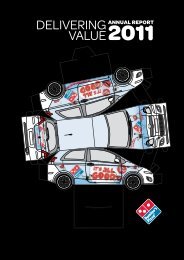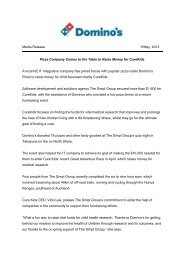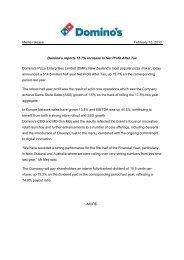2012 Annual Report - Domino's Pizza
2012 Annual Report - Domino's Pizza
2012 Annual Report - Domino's Pizza
Create successful ePaper yourself
Turn your PDF publications into a flip-book with our unique Google optimized e-Paper software.
NOTES TO THE FINANCIAL STATEMENTS CONTINUED<br />
3.23.5 Financial liabilities at FVTPL<br />
Financial liabilities are classified as at FVTPL<br />
when the financial liability is either held for<br />
trading or it is designated as at FVTPL.<br />
A financial liability is classified<br />
as held for trading if:<br />
• it has been acquired principally for the<br />
purpose of repurchasing in the near term; or<br />
• on initial recognition it is a part of an<br />
identified portfolio of financial instruments<br />
that the Consolidated entity manages<br />
together and has a recent actual pattern<br />
of short-term profit-taking; or<br />
• it is a derivative that is not designated<br />
and effective as a hedging instrument.<br />
A financial liability other than a financial<br />
liability held for trading is designated as<br />
at FVTPL upon initial recognition if:<br />
• such designation eliminates or significantly<br />
reduces a measurement or recognition<br />
inconsistency that would otherwise arise; or<br />
• the financial liability forms part of a group<br />
of financial assets or financial liabilities or<br />
both, which is managed and its performance<br />
evaluated on a fair value basis, in accordance<br />
with the Consolidated entity’s documented<br />
risk management or investment strategy,<br />
and information about the grouping is<br />
provided internally on that basis; or<br />
• it forms part of a contract containing<br />
one or more embedded derivatives,<br />
and AASB 139 ‘Financial Instruments:<br />
Recognition and Measurement’ permits<br />
the entire combined contract (asset or<br />
liability) to be designated as at FVTPL.<br />
Financial liabilities at FVTPL are stated at<br />
fair value, with any gains or losses arising<br />
on re-measurement recognised in profit or<br />
loss. The net gain or loss recognised in profit<br />
or loss incorporates any interest paid on the<br />
financial liability and is included in the ‘other<br />
gains and losses’ line item in the statement of<br />
comprehensive income. Fair value is determined<br />
in the manner described in note 32.<br />
3.23.6 Other financial liabilities<br />
Other financial liabilities, including<br />
borrowings, are initially measured at<br />
fair value, net of transaction costs.<br />
Other financial liabilities are subsequently<br />
measured at amortised cost using the effective<br />
interest method, with interest expense<br />
recognised on an effective yield basis.<br />
The effective interest method is a method of<br />
calculating the amortised cost of a financial<br />
liability and of allocating interest expense<br />
over the relevant period. The effective<br />
interest rate is the rate that exactly discounts<br />
estimated future cash payments through<br />
the expected life of the financial liability,<br />
or, where appropriate, a shorter period.<br />
42<br />
3.23.7 Derecognition of financial liabilities<br />
The Consolidated entity derecognises<br />
financial liabilities when, and only when,<br />
the Consolidated entity’s obligations are<br />
discharged, cancelled or they expire.<br />
3.24 Derivative financial instruments<br />
The Consolidated entity enters into a<br />
variety of derivative financial instruments<br />
to manage its exposure to interest rate and<br />
foreign exchange rate risk, including foreign<br />
exchange forward contracts and interest rate<br />
swaps. Further details of derivative financial<br />
instruments are disclosed in note 32.<br />
Derivatives are initially recognised at fair value at<br />
the date a derivative contract is entered into and<br />
are subsequently remeasured to their fair value<br />
at each reporting period. The resulting gain or<br />
loss is recognised in profit or loss immediately<br />
unless the derivative is designated and effective<br />
as a hedging instrument, in which event, the<br />
timing of the recognition in profit or loss depends<br />
on the nature of the hedge relationship. The<br />
Consolidated entity designates certain derivatives<br />
as either hedges of the fair value of recognised<br />
assets or liabilities or firm commitments (fair<br />
value hedges), hedges of highly probable forecast<br />
transactions or hedges of foreign currency risk<br />
of firm commitments (cash flow hedges), or<br />
hedges of net investments in foreign operations.<br />
A derivative with a positive fair value is<br />
recognised as a financial asset; a derivative with<br />
a negative fair value is recognised as a financial<br />
liability. A derivative is presented as a non-current<br />
asset or a non-current liability if the remaining<br />
maturity of the instrument is more than 12<br />
months and it is not expected to be realised or<br />
settled within 12 months. Other derivatives are<br />
presented as current assets or current liabilities.<br />
3.24.1 Hedge accounting<br />
The Consolidated entity designates certain<br />
hedging instruments, which include derivatives,<br />
embedded derivatives and non-derivatives, in<br />
respect of foreign currency risk, as either fair<br />
value hedges, cash flow hedges, or hedges of<br />
net investments in foreign operations. Hedges<br />
of foreign exchange risk on firm commitments<br />
are accounted for as cash flow hedges.<br />
At the inception of the hedge relationship, the<br />
entity documents the relationship between the<br />
hedging instrument and hedged item, along with<br />
its risk management objectives and its strategy<br />
for undertaking various hedge transactions.<br />
Furthermore, at the inception of the hedge and<br />
on an ongoing basis, the Consolidated entity<br />
documents whether the hedging instrument<br />
that is used in a hedging relationship is<br />
highly effective in offsetting changes in fair<br />
values or cash flows of the hedged item.<br />
Note 32 sets out details of the fair values of the<br />
derivative instruments used for hedging purposes.<br />
3.24.2 Fair value hedge<br />
Changes in the fair value of derivatives that are<br />
designated and qualify as fair value hedges<br />
are recognised in profit or loss immediately,<br />
together with any changes in the fair value of the<br />
hedged item that is attributable to the hedged<br />
risk. The change in the fair value of the hedging<br />
instrument and the change in the hedged item<br />
attributable to the hedged risk are recognised<br />
in the line of the statement of comprehensive<br />
income relating to the hedged item.<br />
Hedge accounting is discontinued when the<br />
Consolidated entity revokes the hedging<br />
relationship, when the hedging instrument expires<br />
or is sold, terminated, or exercised, or when it<br />
no longer qualifies for hedge accounting. The<br />
fair value adjustment to the carrying amount of<br />
the hedged item arising from the hedged risk<br />
is amortised to profit or loss from that date.<br />
3.24.3 Cash flow hedge<br />
The effective portion of changes in the fair<br />
value of derivatives that are designated and<br />
qualify as cash flow hedges are recognised in<br />
other comprehensive income. The gain or loss<br />
relating to the ineffective portion is recognised<br />
immediately in profit or loss, and is included<br />
in the ‘other gains and losses’ line item.<br />
Amounts previously recognised in other<br />
comprehensive income and accumulated in<br />
equity are reclassified to profit or loss in the<br />
periods when the hedged item is recognised in<br />
profit or loss in the same line of the statement of<br />
comprehensive income as the recognised hedged<br />
item. However, when the forecast transaction<br />
that is hedged results in the recognition of a<br />
non-financial asset or a non-financial liability, the<br />
gains and losses previously deferred in equity are<br />
transferred from equity and included in the initial<br />
measurement of the cost of the asset or liability.<br />
Hedge accounting is discontinued when the<br />
Consolidated entity revokes the hedging<br />
relationship, when the hedging instrument<br />
expires or is sold, terminated, or exercised, or<br />
no longer qualifies for hedge accounting. Any<br />
gains or losses accumulated in equity at that<br />
time remains in equity and is recognised when<br />
the forecast transaction is ultimately recognised<br />
in profit or loss. When a forecast transaction<br />
is no longer expected to occur, the cumulative<br />
gain or loss that was deferred in equity is<br />
recognised immediately in profit or loss.<br />
3.24.4 Hedges in net investments<br />
in foreign operations<br />
Hedges of net investments in foreign operations<br />
are accounted for similarly to cash flow hedges.<br />
Any gain or loss on the hedging instrument relating<br />
to the effective portion of the hedge is recognised<br />
in other comprehensive income and accumulated<br />
in the foreign currency translation reserve. The<br />
gain or loss relating to the ineffective portion<br />
is recognised immediately in profit or loss and<br />
included in the ’other gains and losses’ line item.<br />
Gains and losses on hedging instrument relating<br />
to the effective portion of the hedge accumulated<br />
in the foreign currency translation reserve<br />
are reclassified to profit or loss in the same<br />
way as exchange differences relating to the<br />
foreign operation as described at 3.6 above.<br />
ANNUAL REPORT <strong>2012</strong> DOMINO’S PIZZA ENTERPRISES LIMITED













